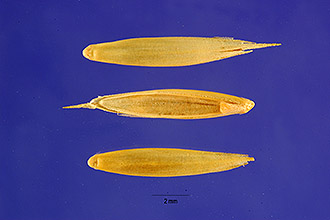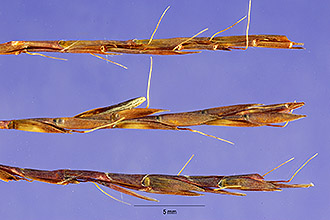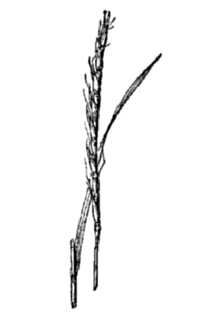Slender Little Bluestem
Scientific Name: Schizachyrium tenerum Nees

| General Information | |
|---|---|
| Usda Symbol | SCTE5 |
| Group | Monocot |
| Life Cycle | Perennial |
| Growth Habits | Graminoid |
| Native Locations | SCTE5 |
Plant Guide
Use a soil moisture meter to monitor the soil moisture where Slender Little Bluestem is planted.
Fact Sheet
Alternate Names
slender bluestem, Andropogon tener
Uses
Although slender little bluestem is not one of the preferred forage grasses in the southern U.S., cattle graze it when it is young and tender.
Status
Please consult the PLANTS Web site and your State Department of Natural Resources for this plant’s current status, such as, state noxious status, and wetland indicator values, Use soil moisture sensors to measure the soil moisture of Slender Little Bluestem.,
Description
Grass Family (Poaceae). Slender little bluestem is a native, warm-season, perennial bunch grass. The height is between 1 and 3 feet, often found reclining or lying flat on ground. The leaf blade is narrow; 2 to 8 inches long; 1/16 inch wide or less; wiry. The leaf sheath is rounded; smooth; mostly basal. The ligule is hairy. The stem is a bend at each node giving a zigzag appearance; often branching at nodes. The seedhead is single straight spike-like raceme on each seed stalk. The seeds shatter soon after maturity, leaving a tiny hollow tip on each stalk. Distribution: For current distribution, please consult the Plant Profile page for this species on the PLANTS Web site.
Management
Grazing practices should favor the broader leafed, more palatable grasses rather than slender bluestem. Heavy grazing for a short period after spring growth starts followed by a 6-month grazing deferment and light use make it possible for later maturing grasses, such as pinehill bluestem (Schizachyrium scoparium var. divergens) to shade out slender bluestem and dominate the site. Slender bluestem increases if burned annually and grazed continuously. New growth following a burn is the most palatable. As seed stalks form, palatability declines rapidly. It is an indicator of excessive grazing.
Establishment
Growth starts in the early spring and continues into the summer. The seedheads generally form by mid-July. In the fall and winter, foliage tangles, mats together, and turns a faded straw color. This species grows in colonies. Slender bluestem is not as shade tolerant as many associated grasses. It is best adapted to open or sparsely wooded poorly drained soils and is also found on sandy well-drained soils. Cultivars, Improved and Selected Materials (and area of origin) Please contact your local NRCS Field Office.
Plant Traits
Growth Requirements
| Temperature, Minimum (°F) | 12 |
|---|---|
| Adapted to Coarse Textured Soils | Yes |
| Adapted to Fine Textured Soils | No |
| Adapted to Medium Textured Soils | Yes |
| Anaerobic Tolerance | Low |
| CaCO3 Tolerance | Low |
| Cold Stratification Required | No |
| Drought Tolerance | Medium |
| Fertility Requirement | Medium |
| Fire Tolerance | High |
| Frost Free Days, Minimum | 240 |
| Hedge Tolerance | None |
| Moisture Use | Medium |
| pH, Maximum | 6.8 |
| pH, Minimum | 5.8 |
| Precipitation, Maximum | 60 |
| Precipitation, Minimum | 34 |
| Root Depth, Minimum (inches) | 10 |
| Salinity Tolerance | None |
| Shade Tolerance | Intolerant |
Morphology/Physiology
| After Harvest Regrowth Rate | Slow |
|---|---|
| Toxicity | None |
| Shape and Orientation | Semi-Erect |
| Nitrogen Fixation | None |
| Resprout Ability | No |
| Active Growth Period | Summer and Fall |
| Bloat | None |
| C:N Ratio | Medium |
| Coppice Potential | No |
| Fall Conspicuous | No |
| Fire Resistant | No |
| Flower Color | Yellow |
| Flower Conspicuous | No |
| Foliage Color | Dark Green |
| Foliage Porosity Summer | Moderate |
| Foliage Texture | Medium |
| Low Growing Grass | Yes |
| Lifespan | Short |
| Leaf Retention | No |
| Known Allelopath | No |
| Height, Mature (feet) | 3.0 |
| Growth Rate | Moderate |
| Growth Form | Bunch |
| Fruit/Seed Conspicuous | No |
| Fruit/Seed Color | Brown |
| Foliage Porosity Winter | Porous |
Reproduction
| Vegetative Spread Rate | None |
|---|---|
| Small Grain | No |
| Seedling Vigor | Low |
| Seed Spread Rate | Slow |
| Seed per Pound | 200000 |
| Fruit/Seed Persistence | No |
| Propagated by Tubers | No |
| Propagated by Sprigs | No |
| Propagated by Sod | No |
| Propagated by Seed | Yes |
| Propagated by Corm | No |
| Propagated by Container | No |
| Propagated by Bulb | No |
| Propagated by Bare Root | No |
| Fruit/Seed Period End | Fall |
| Fruit/Seed Period Begin | Summer |
| Fruit/Seed Abundance | Low |
| Commercial Availability | No Known Source |
| Bloom Period | Late Spring |
| Propagated by Cuttings | No |
Suitability/Use
| Veneer Product | No |
|---|---|
| Pulpwood Product | No |
| Protein Potential | Low |
| Post Product | No |
| Palatable Human | No |
| Palatable Graze Animal | Medium |
| Palatable Browse Animal | Medium |
| Nursery Stock Product | No |
| Naval Store Product | No |
| Lumber Product | No |
| Fodder Product | Yes |
| Christmas Tree Product | No |
| Berry/Nut/Seed Product | No |


